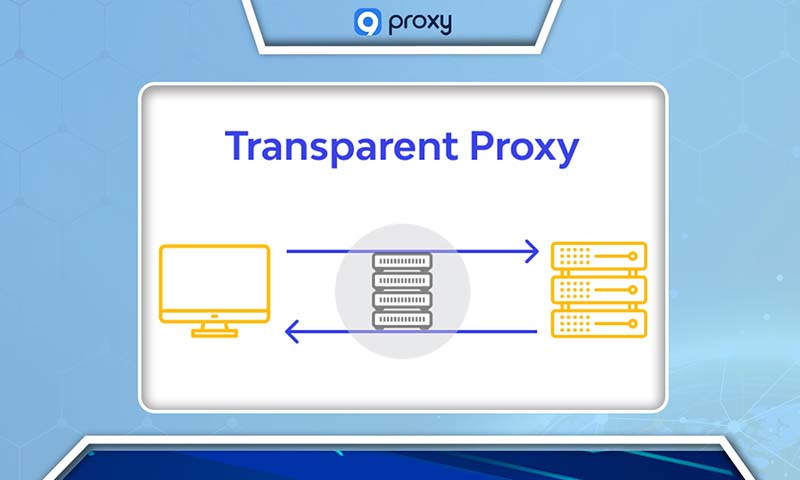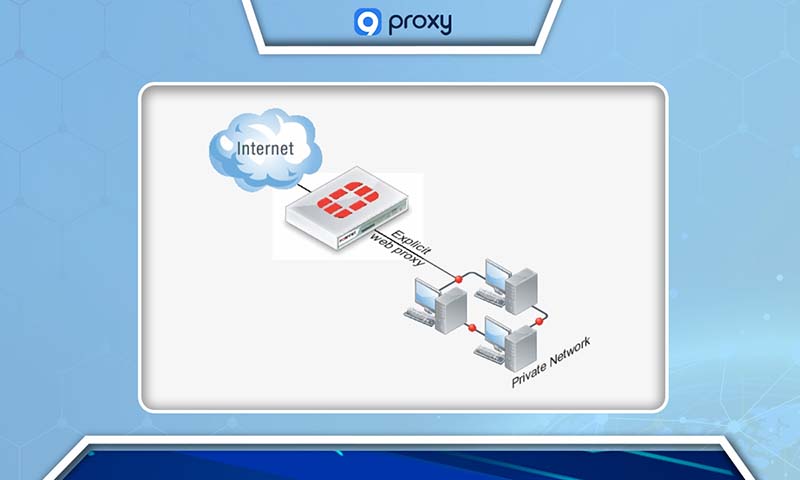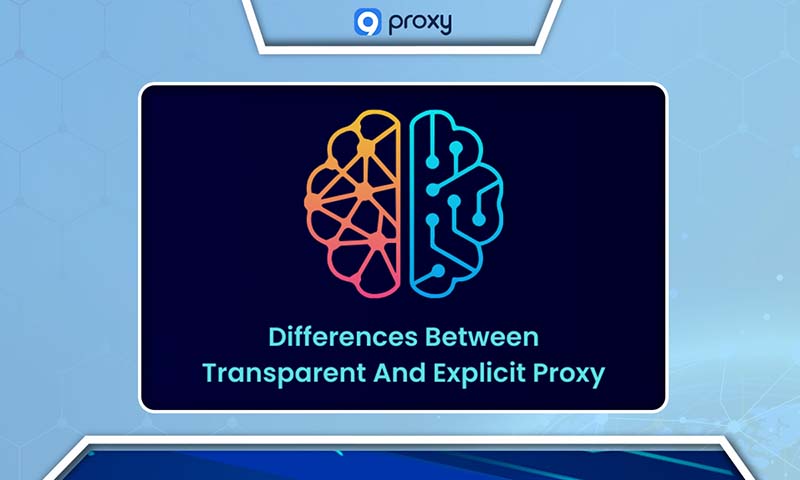Transparent Proxy vs Explicit Proxy: Details the Difference
Welcome to our comprehensive guide on the distinct roles and benefits of Transparent vs Explicit proxy. This exploration aims to equip you with the essential knowledge to make an informed decision about the most suitable proxy type for your organization.
Are you finding it difficult to choose between an explicit proxy and a transparent proxy for your company's network? Each type of proxy has its own set of advantages and challenges. Choosing the right proxy can significantly impact your network's security, performance, and transparency. In this guide on transparent proxy vs explicit proxy, we conduct a detailed comparison of both proxies, considering various critical factors.
What Is Transparent Proxy?
A transparent proxy, also known as an inline or intercepting proxy, automatically routes all internet traffic through itself without requiring any configuration on the client’s device. This type of proxy does not alter the requests and is seamlessly integrated into your network infrastructure. A popular example of this kind of technology is the Squid Transparent Proxy Server.
Often referred to as forced proxies, transparent proxies can be implemented into a user’s connection without altering any settings on their computer. This method is frequently used by internet service providers (ISPs) to manage traffic efficiently. As a user, you might be interacting with transparent proxies regularly when you visit popular websites, stream movies, or read news articles, all without your explicit awareness.
Despite operating invisibly — hence the name 'transparent' — these proxies monitor and sometimes redirect your internet traffic. Notably, not all transparent proxies are used with malicious intent; they primarily serve to enhance network efficiency and manage bandwidth. However, they can be used to intercept data without the user’s consent.
To detect if you're under a transparent proxy, try connecting to a server. In the absence of a proxy, your browser might display a standard error message, like Chrome indicating it cannot find the IP address. If a proxy is in use, the error message might differ, or your browser could redirect you to another page, such as a search engine or a custom error page.

Advantages and Disadvantages of Transparent Proxy
Transparent proxies are crucial tools in network management, balancing beneficial features against potential risks. Here's an overview of their pros and cons:
Advantages:
- Ease of Deployment: Transparent proxies are incredibly easy to deploy because they do not require any configuration on the client’s end. This makes them ideal for large networks where extensive individual device setups are impractical.
- Content Management: These proxies facilitate content filtering and caching directly, bypassing the need for individual client configurations. This can significantly enhance network efficiency and reduce latency.
- Surveillance Capability: Transparent proxies can monitor and eavesdrop on any application traffic passing through them, including during the initial three-way handshake in TCP/IP communications. This feature is particularly useful for administrative monitoring and network diagnostics.
Disadvantages:
- Lower Security: Transparent proxies are generally considered less secure than explicit proxies. Because they do not require client-side acknowledgment or configuration, it’s easier for malicious entities to exploit them unnoticed.
- Potential for Network Redesign: Implementing a transparent proxy might necessitate changes in the existing network architecture to accommodate new routing patterns and traffic management strategies.
- Privacy Concerns: These proxies can access sensitive information without the client's knowledge, raising significant privacy issues. This lack of transparency can be problematic, especially in environments where data confidentiality is critical.
- SSL Interception Challenges: Transparent proxies cannot authenticate traffic that needs to bypass SSL interception. This limitation makes it challenging to secure and verify encrypted data streams, potentially leaving them vulnerable to interception and decryption.
What Is Explicit Proxy?
An explicit proxy, unlike its transparent counterpart, requires deliberate configuration on the client's device. Users must manually enter the proxy’s IP address and port number, ensuring that all application traffic is routed directly through the proxy server. This setup ensures that the destination IP and port for all outgoing packets are consistently directed towards the proxy.
The key advantage of an explicit proxy is the heightened control it offers network administrators. By requiring direct configuration, explicit proxies allow for more stringent management of network traffic. Administrators can implement specific rules, monitor user behavior, and filter content effectively. Additionally, these proxies play a crucial role in enforcing security policies and preventing data breaches.
Explicit proxies are highly customizable, allowing network administrators to tailor them according to the specific needs of their network environment. This adaptability makes explicit proxies particularly valuable in settings where precise control over internet access and data security is necessary.

Advantages and Disadvantages of Explicit Proxy
Explicit proxies are specialized tools that play a crucial role in network security and traffic management. They have several advantages and disadvantages that organizations must consider before implementation:
Advantages:
- Enhanced Security: Explicit proxies provide superior security compared to transparent proxies. By requiring specific client configurations, they reduce the likelihood of unauthorized access and are less susceptible to being exploited by attackers.
- Granular Control: These proxies allow for meticulous control over internet traffic. Administrators can enforce detailed rules on what can be accessed and what should be blocked, enabling more effective management of network resources.
- Content Filtering and Website Blocking: With explicit proxies, administrators have the capability to filter out unwanted content and block access to specific websites. This feature is particularly valuable in maintaining organizational standards and compliance.
Disadvantages:
- Complex Deployment: Explicit proxies are generally more challenging to deploy than transparent proxies. They require modifications to client settings, which can be time-consuming and technically demanding.
- Configuration Time: Setting up each client to use the proxy takes considerable effort and time. This setup process can be a significant hurdle in large organizations with many users.
- Risk of Misconfiguration: Due to the complexity and necessity of client-side configuration, there is a higher risk of misconfiguration, which can lead to security gaps or network disruptions.
Differences Between Transparent and Explicit Proxy
While transparent vs explicit proxy serves similar foundational purposes in managing internet traffic, their operational characteristics and implications for network management differ significantly. Here's a comparative analysis based on various critical aspects:

- Performance: Transparent proxies are generally faster and more streamlined since they do not require any client-side configuration. They seamlessly intercept and direct traffic, which can enhance speed and efficiency for routine web browsing and data handling. However, if not properly configured, transparent proxies can introduce latency and other performance issues. In contrast, explicit proxies might slightly reduce speed due to the overhead of client-side configuration and rigorous traffic handling processes.
- Control: Explicit proxies offer network administrators much more granular control over internet traffic. They enable the implementation of specific rules, tracking of user behavior, and extensive content filtering capabilities. Transparent proxies, while effective for general caching and load balancing, offer less precise control over the content and cannot enforce detailed user-specific policies.
- Security: Explicit proxies are superior in terms of security. They allow for strict policy enforcement and content filtering, directly managed by administrators. Transparent proxies, while useful, pose a risk by potentially exposing user data through interception and inspection processes that occur without the users' knowledge or consent.
- Visibility: There is a distinct difference in visibility between the two proxy types. With transparent proxies, users remain unaware that their traffic is being rerouted. This lack of transparency can be a concern in scenarios requiring user consent or awareness. On the other hand, explicit proxies are fully visible to users, as their configuration necessitates direct user input, ensuring users are aware that their traffic is being processed through a proxy server.
- Configuration: The setup process also differs markedly. Explicit proxies require users to manually configure their network settings to route traffic through the proxy, involving a specific setup on each client device. Transparent proxies, in contrast, operate invisibly from the user’s point of view, requiring no client-side configuration and allowing for a quicker and less intrusive deployment.
Which Proxy Type Is a Best Fit for Your Company?
Choosing the right proxy largely depends on your company's specific needs and objectives.
If your business prioritizes content filtering and simplicity in setup, a transparent proxy might be the way to go. This type of proxy is great for companies that need straightforward solutions without a complex setup process.
On the other hand, if security is your primary concern and you require detailed control over internet access and traffic, an explicit proxy is likely a better choice. Explicit proxies provide enhanced security measures and give administrators the ability to tailor the proxy settings to meet specific network requirements. This includes the flexibility to modify and adjust the proxy to align with unique network demands.
Each type of proxy has its own set of pros and cons, and there is no one-size-fits-all solution. The decision should be based on a thorough evaluation of your company’s specific needs and requirements. By understanding these factors, you can select the proxy that optimally supports your organizational goals.
FAQ
Which type of proxy is better for privacy?
When it comes to privacy, explicit proxies are generally preferred due to their secure and controlled connection settings. Users are explicitly aware that their data is being routed through a proxy and can adjust settings to suit their privacy needs. While transparent proxies are effective for enforcing organizational policies, they do not typically offer users the same level of control over their individual privacy.
How do users know if they are behind a proxy?
Detecting a proxy can often be achieved by checking the network settings on a user’s system or using online tools that examine IP addresses and headers for proxy indicators. In the case of explicit proxies, awareness is usually higher since configuration is done manually, making it apparent that a proxy is in use.
Are there legal considerations with using proxies?
Yes, using proxies, whether transparent or explicit, involves legal considerations, especially concerning user privacy and data protection. Organizations must ensure compliance with local and international laws, such as the General Data Protection Regulation (GDPR) in Europe or the Health Insurance Portability and Accountability Act (HIPAA) in the United States. This is crucial when intercepting and processing users' data. Transparent proxies require particularly careful management to guarantee that privacy rights are not violated without the users’ informed consent.
Conclusion
Both explicit and transparent proxies present distinct advantages and challenges. In the debate of transparent proxy vs explicit proxy, transparent proxies are valued for their ease of configuration and are commonly used in environments like government buildings, corporate offices, and educational institutions. However, they may lack the robust security features of explicit proxies, particularly in areas like content filtering and data caching.
On the other hand, explicit proxies are renowned for their enhanced security and the detailed control they offer over internet traffic. This makes them ideal for environments where security is a critical concern, even though they are more complex to set up.
It's not uncommon for the majority of internet users to interact with transparent proxies daily without even realizing it. These proxies can potentially be exploited by attackers to monitor internet traffic or redirect users to malicious sites, highlighting the need for careful security measures.
Before deciding which type of proxy is right for your needs, consider reviewing the benefits, drawbacks, and security implications detailed earlier. Weigh each proxy's configuration, visibility, security, performance, and control capabilities to make an informed decision that aligns with your organizational or personal requirements.
Get Newsletters About Everything Proxy-Related